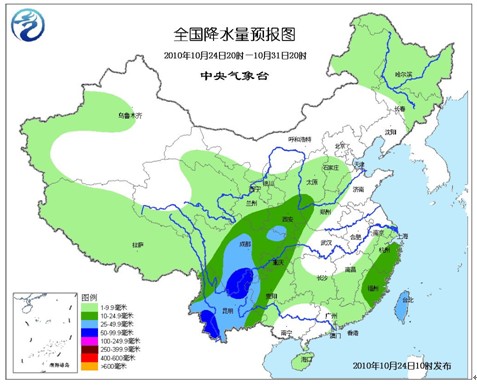
National Precipitation Forecast Chart (October 24, 2010, 20:00-31 20:00)
Since the 21st to the 23rd, the strongest cold air since the fall has affected the northern part of China, and the northwestern region, Inner Mongolia, North China, Northeast China and other places have obvious windy and cool weather. The average daily in northern Xinjiang, central Gansu, eastern Inner Mongolia and Heilongjiang The maximum temperature drop is 6~12°C; the strong winds of 5~7 in most parts of Xinjiang, the local gusts reach 9-10, and the instantaneous winds of the "Thirty Miles" and "Bali" wind zones have 12 levels. Dust weather occurred in the Xinjiang Basin, and there was a strong sandstorm with a visibility of less than 200 meters in Minfeng.
Affected by cold air, from 08:00 to 14:00 on the 21st, in northern Xinjiang, southern Qinghai, Gansu, Ningxia, central and northern Shaanxi, central and western Inner Mongolia, central and northern Shanxi, central Hebei, Beijing, northern Heilongjiang, etc. ~ 30 mm of rainfall (snow) or sleet, Xinjiang Yining (48 mm), Baicheng (63 mm) precipitation is large.
It is expected that strong cold air will continue to affect in the central and eastern regions of China
At present, it is affecting the strong cold air in parts of northern China. It is expected to affect the eastern part of the northwestern part of the northeast, northeast, north China, Huanghuai, Jianghuai, Jianghan, Jiangnan, South China and the southwest of the southwest region on the 24th to 26th. Most of the above areas will have 4 to 6 northerly winds, and the rivers and lakes have 5 to 7 winds, and the gust winds can reach 8 levels. The temperature will drop by 6~12 °C, and the temperature drop in some areas can reach 14~16 °C. After the cold air striker, the daily minimum temperature in the North China Plain and Huanghuai area can reach 0-5 °C, and the Jianghuai, Hanshui River Basin, the central and northern Jiangnan, and the Yunnan-Guizhou Plateau have 6-8 °C. There will be sleet or small to medium snow in the central and western Gansu, northern Qinghai, Ningxia, and northwestern Shaanxi, and there will be heavy snow in the local area. Initial frosts will occur in parts of central and southern Shaanxi, south-central Shanxi, central and southern Hebei, Beijing, Tianjin, Shandong, Henan, northern Anhui, and northern Jiangsu. From the 24th to the 27th, there will be 8 to 9 winds in the eastern and southern sea areas of China, and the gust winds can reach 10 to 11 levels.
From the 29th to the 30th, there will be about 4 northerly winds in the eastern, northeast and north China of the northwestern region, and the temperature will drop by 3-6 °C; there will be 6-8 winds in the eastern seas.
In addition, in the coming week, there will be a tropical storm in the northwestern Pacific Ocean, which will be affected by it. From the 25th to the 29th, there will be 6-8 winds in the east of Taiwan, the Taiwan Strait and the East China Sea. Up to 9 to 12 levels.
In the next three days, strong cold air will continue to affect China and will have an adverse impact on agricultural production. Recommendation:
The first is to prevent the adverse effects of rain and snow on transportation. The relevant areas should strengthen the inspection and maintenance of traffic infrastructure and traffic diversion, and pay attention to the impact of low visibility and road snow and ice on road transport. Due to the large winds on the rivers and rivers, it is recommended not to carry out surface operations and ship navigation during the gale period, and at the same time pay attention to the protection of the adverse effects of strong wind cooling on aquaculture in inland rivers and lakes and coastal areas.
The second is to strengthen the management of agricultural production and prevent the danger of high temperature and low temperature frost. All localities need to do the wind-proof reinforcement work in greenhouses; the winter wheat area in the north should strengthen the field management, timely watering and warming, and prevent the adverse effects of low temperature and frost; Xinjiang and other places should seize the time to grab cotton, and Inner Mongolia and other pastoral areas should be good livestock. The wind and cold protection work; the rapeseed area in the Yangtze River Basin should take measures such as covering to prevent rapeseed seedlings from being exposed to high winds and low temperature.
The third is to prevent the adverse effects of cooling and precipitation on the lives of the people. Relevant departments should do a good job in power supply, heating, gas supply, etc., use coal-fired heating areas to pay attention to fire safety and management, and pay attention to prevent urban and rural fires; the health department needs to strengthen the prevention and control of diseases such as influenza.
Total 1 | <First <Prev 1 Next> Last> |
share to:
Light Steel Nursing Homes
The Nursing home can be designed by several or more than a dozen with less than 5 floors low-rise building in parallel.
Each area is around 150-150 square meters, and has its own independent garden, there is special carport. A lot of people prefer such kind of building as it can satisfy their need for good living environments. It can provide a feeling of "loose, comfortable, quiet, free and independent".
Internal environment
comfortable inside, like staying at home. With Full set of furniture and house applicants in Bedroom, living room, kitchen, bathroom.
Entertainment
Chess &cards room, cinema, reading room, billiards room is for optional. It makes life more fulfilling.
Rest Home Villa,Nursing Home Buildings,Metal House,Light Steel Nursing House
HEBEI WEIZHENGHENG MODULAR HOUSE TECH CO., LTD , http://www.sinowzh.com